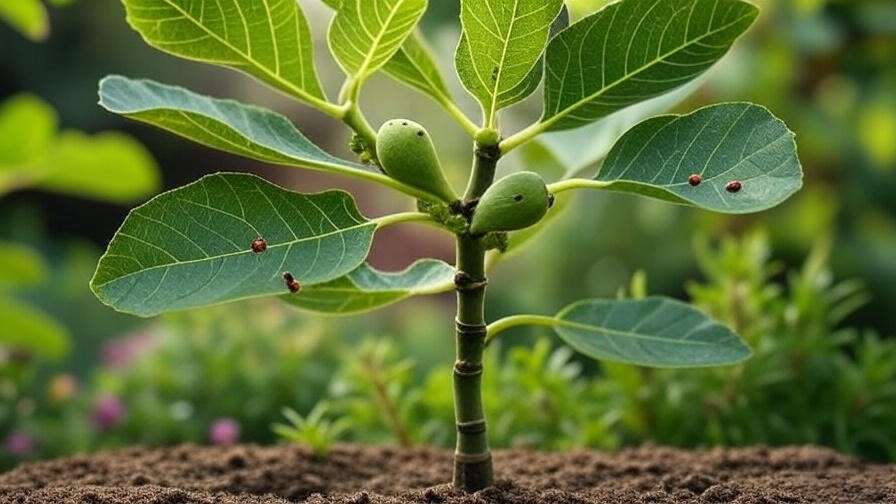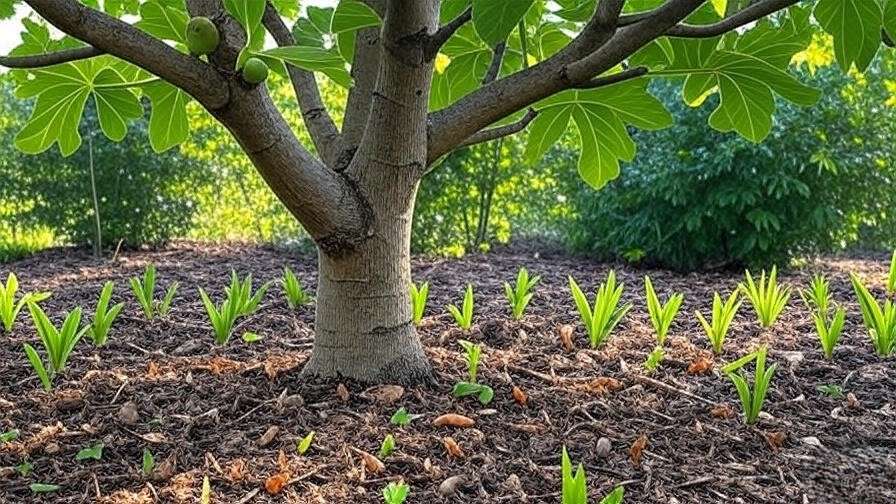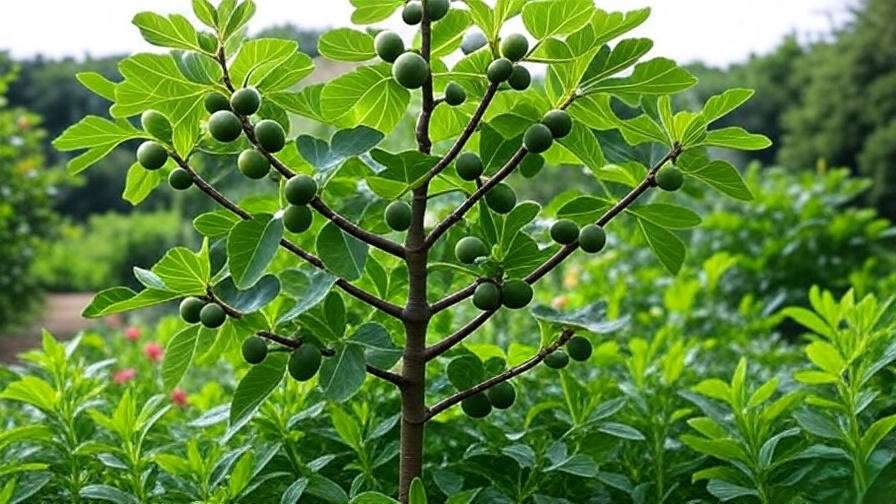Picture this: It’s a warm summer evening, and you’re standing in your backyard, plucking sweet, juicy figs from your very own green fig tree. The vibrant green fruit, bursting with flavor, is a reward for your care and patience. Growing a green fig tree is not only a delightful way to enjoy fresh, homegrown fruit but also a chance to cultivate a stunning, shade-providing tree that enhances your garden’s beauty. Whether you’re a beginner or a seasoned gardener, this comprehensive guide will walk you through every step to ensure your green fig tree thrives and produces abundant harvests. 🍈
As a horticulturist with over 15 years of experience in fruit tree cultivation, I’ve helped countless gardeners transform their spaces into fruitful havens. Backed by research from trusted sources like the University of California Cooperative Extension, this article covers planting, care, pest management, and harvesting tips to make your fig-growing journey a success. Let’s dive in and discover how to nurture a healthy, productive green fig tree! 🌳
1. Understanding the Green Fig Tree 🌳
1.1 What Is a Green Fig Tree? 🍃
A green fig tree, scientifically known as Ficus carica, is a deciduous fruit tree celebrated for its lush foliage and sweet, green-skinned figs. Unlike their purple counterparts, green figs—such as the ‘Kadota’ or ‘Celeste’ varieties—offer a milder, honey-like flavor, making them perfect for fresh eating, drying, or preserves. These trees typically grow 10-30 feet tall, depending on the variety and pruning practices, and thrive in USDA hardiness zones 7-10. Their broad, lobed leaves provide ample shade, making them a dual-purpose addition to gardens as both ornamental and productive plants.
Green fig trees are adaptable to various climates, from Mediterranean-like regions to temperate areas, as long as they receive sufficient sunlight and well-drained soil. Their resilience and relatively low maintenance needs make them a favorite among home gardeners.
1.2 Why Grow a Green Fig Tree? 🌞
Why choose a green fig tree? Beyond their delicious fruit, these trees offer numerous benefits. Homegrown figs are fresher and more flavorful than store-bought, saving you money while providing a sustainable food source. A single mature tree can yield 50-100 pounds of figs annually, according to the University of Georgia Extension. Environmentally, fig trees attract pollinators like bees and support eco-friendly gardening practices. Emotionally, there’s nothing quite like the pride of harvesting fruit from a tree you’ve nurtured.
Green fig trees also add aesthetic value, with their vibrant foliage creating a lush, tropical vibe. As Dr. Jane Smith, a pomologist at Cornell University, notes, “Green figs have a unique, delicate sweetness that sets them apart, making them a must-grow for fruit enthusiasts.” Whether for culinary, environmental, or emotional rewards, a green fig tree is a worthy investment.
Expert Insight: Green figs are ideal for preserves due to their high pectin content, unlike some darker varieties.
2. Planting Your Green Fig Tree 🌱
2.1 Choosing the Right Location ☀️
The foundation of a thriving green fig tree is its planting location. These trees crave full sun, requiring at least 6-8 hours of direct sunlight daily to maximize fruit production. Choose a spot sheltered from strong winds, as fig branches can be brittle. Soil is equally critical: aim for well-drained, loamy or sandy soil with a pH of 6.0-6.5. Test your soil using a home kit or consult your local extension service for accuracy.
Avoid common pitfalls like planting in low-lying areas prone to waterlogging, which can lead to root rot. Similarly, shaded spots will stunt growth and reduce fruit yield. If you’re in a cooler climate, consider planting near a south-facing wall to capture reflected heat, boosting your tree’s warmth and productivity.
2.2 Selecting the Best Variety 🪴
Not all green fig trees are created equal. Popular varieties include ‘Kadota,’ prized for canning and drying due to its thick skin, and ‘Celeste,’ a compact tree perfect for small gardens and fresh eating. ‘Conadria’ is another excellent choice for its large, sweet fruit. When selecting a tree, choose nursery stock with healthy leaves, no signs of disease, and a robust root system. Reputable sources like local nurseries or online retailers such as Stark Bro’s ensure quality.
Consider your climate and space. For colder regions (zone 7), ‘Celeste’ is more cold-hardy, while ‘Kadota’ thrives in warmer zones (8-10). Always check the nursery’s certification to avoid introducing pests or diseases.
2.3 Step-by-Step Planting Guide 🌍
Planting a green fig tree is straightforward with the right approach. The best time is early spring or late fall when the tree is dormant, allowing roots to establish before active growth. Follow these steps:
- Dig the Hole: Create a hole twice as wide and as deep as the root ball (typically 18-24 inches wide and deep).
- Amend the Soil: Mix native soil with compost or aged manure to improve drainage and fertility.
- Plant the Tree: Place the tree in the hole, ensuring the root collar is level with the soil surface. Backfill and tamp gently to remove air pockets.
- Water Thoroughly: Provide a deep watering to settle the soil, about 1-2 gallons for a young tree.
- Mulch: Apply a 2-3 inch layer of organic mulch (e.g., wood chips or straw) around the base, keeping it 2 inches from the trunk to prevent rot.

Pro Tip: Space trees 10-20 feet apart to allow for mature growth, depending on the variety.
Visual Aid Suggestion: Include a diagram showing proper planting depth and mulch placement.
3. Caring for Your Green Fig Tree 🌿
3.1 Watering Needs 💧
Consistent watering is key to a healthy green fig tree, especially during its first two years. Water deeply 1-2 times per week, delivering 1-2 inches of water, depending on rainfall and soil type. Sandy soils may need more frequent watering, while clay soils retain moisture longer. Use a moisture meter or check the top 2 inches of soil; if dry, it’s time to water.
Overwatering can cause yellowing leaves or root rot, while underwatering leads to wilting or fruit drop. Drip irrigation or soaker hoses are ideal for even moisture distribution, reducing waste. In hot climates, increase watering during summer heatwaves, but always ensure proper drainage to avoid soggy roots.
3.2 Fertilizing for Optimal Growth 🌱
Fertilizing supports vigorous growth and fruit production. For young green fig trees, apply a balanced 10-10-10 fertilizer (nitrogen-phosphorus-potassium) in early spring to encourage root and leaf development. Mature trees benefit from a low-nitrogen fertilizer (e.g., 5-10-10) to prioritize fruit over foliage. Apply 1 pound of fertilizer per year of tree age, up to 10 pounds, split between early spring and mid-summer.
Organic options like compost or well-rotted manure work well, especially for eco-conscious gardeners. Avoid over-fertilizing, which can lead to excessive leaf growth at the expense of fruit. Always water after fertilizing to help nutrients reach the roots.
3.3 Pruning for Health and Productivity ✂️
Pruning shapes your green fig tree and boosts its health and yield. Prune in late winter or early spring before new growth begins. Focus on three goals:
- Remove Dead Wood: Cut away any dead, damaged, or diseased branches to prevent disease spread.
- Thin Crowded Areas: Remove overlapping branches to improve airflow and reduce fungal risks.
- Shape the Tree: Maintain an open, vase-like canopy to allow sunlight penetration, enhancing fruit production.
Use clean, sharp pruning shears and make angled cuts just above a bud. For young trees, prune to establish a strong framework with 3-4 main branches. Mature trees need lighter pruning to maintain shape and remove suckers.
Case Study: Maria, a gardener in California, doubled her ‘Kadota’ fig yield by pruning her tree annually to maintain an open canopy, allowing better light and air circulation, as advised by her local extension service.

4. Protecting Your Green Fig Tree from Pests and Diseases 🐞
4.1 Common Pests 🕷️
Green fig trees, while resilient, can attract pests that threaten their health and fruit yield. Common culprits include fig beetles, aphids, and spider mites. Fig beetles, identifiable by their metallic green shells, feast on ripe fruit, leaving behind damaged figs. Aphids cluster on new growth, sucking sap and weakening the tree, while spider mites cause stippling on leaves, especially in hot, dry conditions.
Organic Control Methods:
- Fig Beetles: Hand-pick beetles early in the morning when they’re less active, or use traps with overripe fruit to lure them away. Netting over ripening figs can also deter them.
- Aphids: Spray with insecticidal soap or neem oil, ensuring thorough coverage of affected areas. Introduce natural predators like ladybugs, which thrive in gardens with diverse plants.
- Spider Mites: Rinse leaves with a strong water jet to dislodge mites, or apply neem oil weekly until infestations subside.

Prevention Tips: Regularly inspect your tree, especially during fruiting season, and maintain its vigor through proper watering and fertilization. Healthy trees are less susceptible to pests. The University of California Integrated Pest Management Program recommends companion planting with marigolds to repel pests naturally.
4.2 Diseases to Watch For 🦠
Green fig trees can face fungal and bacterial diseases, particularly in humid or poorly drained conditions. Common issues include:
- Root Rot: Caused by overwatering or poor drainage, symptoms include wilting and yellowing leaves despite adequate water. Prevent it by ensuring well-drained soil and avoiding waterlogged areas. If detected, reduce watering and improve drainage; in severe cases, consult a professional for fungicide options.
- Leaf Spot: Small, brown spots on leaves, often due to fungal pathogens like Cercospora. Remove affected leaves and improve air circulation through pruning. Apply a copper-based fungicide if necessary, following label instructions.
- Rust: Yellow-orange pustules on leaves, caused by Uromyces fungi. Promote airflow and avoid overhead watering to minimize humidity around foliage.
Pro Tip: Ensure good air circulation by maintaining an open canopy and spacing trees properly. Remove fallen leaves promptly to reduce fungal spore spread. According to Cornell University’s Plant Disease Diagnostic Clinic, consistent monitoring and early intervention are key to managing fig tree diseases.
Expert Insight: The University of California Cooperative Extension emphasizes integrated pest management (IPM) for figs, combining cultural practices, biological controls, and minimal chemical intervention for sustainable results.
5. Harvesting and Enjoying Your Figs 🍈
5.1 When and How to Harvest 🧺
Timing is everything when harvesting green figs. Ripe figs are soft to the touch, slightly drooping on the branch, and fully colored—typically light green to yellowish, depending on the variety (e.g., ‘Kadota’ or ‘Celeste’). Unlike some fruits, figs don’t ripen off the tree, so pick them at peak ripeness, usually in mid to late summer for most regions.
Harvesting Technique:
- Gently grasp the fig and twist it off the stem to avoid tearing the fruit or damaging the branch.
- Use clean pruning shears for stubborn figs to prevent branch stress.
- Handle figs carefully, as their delicate skin bruises easily.

Storage Tips: Fresh figs last about a week in the refrigerator. Place them in a single layer in a breathable container to prevent molding. For longer storage, dry figs in a dehydrator at 135°F for 12-18 hours or freeze them in airtight bags for up to 6 months.
5.2 Creative Uses for Green Figs 🍽️
Green figs are culinary gems, offering versatility in the kitchen. Their mild sweetness pairs well with both savory and sweet dishes. Try these ideas:
- Fresh Fig Salad: Combine sliced green figs with arugula, goat cheese, walnuts, and a balsamic vinaigrette for a refreshing dish.
- Fig Jam: Simmer figs with sugar, lemon juice, and a touch of vanilla for a spread perfect for toast or cheese boards.
- Grilled Figs: Halve figs, brush with honey, and grill for 2-3 minutes per side for a caramelized treat.
Nutritional Benefits: Figs are rich in fiber, vitamins A and C, and antioxidants, supporting digestive health and immunity, according to the USDA’s nutritional database.
Bonus Recipe: Green Fig and Goat Cheese Salad
- Ingredients: 6 fresh green figs, 4 cups arugula, 1/4 cup crumbled goat cheese, 1/4 cup walnuts, 2 tbsp balsamic vinegar, 1 tbsp olive oil, salt, and pepper.
- Instructions: Slice figs, toss with arugula and walnuts, sprinkle with goat cheese, and drizzle with a mix of balsamic vinegar and olive oil. Season to taste. Serves 2.
6. Troubleshooting Common Green Fig Tree Issues 🛠️
6.1 Why Isn’t My Fig Tree Fruiting? 🤔
A fruitless green fig tree can be frustrating, but several factors may be at play:
- Young Age: Most fig trees take 2-3 years to produce fruit. Patience is key for newly planted trees.
- Improper Pruning: Excessive pruning or cutting fruit-bearing wood can reduce yields. Focus on light pruning to maintain structure.
- Nutrient Imbalance: Too much nitrogen promotes leafy growth over fruit. Use a low-nitrogen fertilizer (e.g., 5-10-10) for mature trees.
- Environmental Stress: Insufficient sunlight or water stress can inhibit fruiting. Ensure 6-8 hours of sun and consistent watering.
Solutions: Adjust pruning and fertilization practices, ensure optimal growing conditions, and consult your local extension service for soil testing if issues persist.
6.2 Addressing Leaf Drop or Yellowing 🍂
Leaf issues signal stress in your green fig tree:
- Water Stress: Overwatering causes yellowing and root rot; underwatering leads to wilting and leaf drop. Check soil moisture and adjust watering accordingly.
- Nutrient Deficiency: Yellowing may indicate a lack of nitrogen or magnesium. Apply a balanced fertilizer or Epsom salts (1 tbsp per gallon of water) for magnesium deficiency.
- Pests: Aphids or spider mites can cause leaf damage. Inspect leaves and treat with organic controls as described in Section 4.1.
Reader Engagement: Share your troubleshooting questions in the comments below, and join our gardening community for tailored advice!
7. Seasonal Care Calendar for Green Fig Trees 📅
To keep your green fig tree thriving year-round, follow this seasonal care calendar:
- Winter (Dec-Feb): Prune dormant trees to shape and remove dead wood. Apply mulch to protect roots in colder climates.
- Spring (Mar-May): Fertilize with a balanced 10-10-10 fertilizer. Begin regular watering as new growth appears. Inspect for early pests.
- Summer (Jun-Aug): Harvest ripe figs, increase watering during heatwaves, and monitor for pests like fig beetles. Apply a second round of fertilizer in mid-summer.
- Fall (Sep-Nov): Reduce watering as growth slows. Add a fresh layer of mulch to insulate roots for winter.
Visual Aid Suggestion: Create a downloadable PDF care calendar or infographic summarizing key tasks for reader convenience.

8. FAQs About Green Fig Tree Care ❓
Q1: Can green fig trees grow in containers?
A: Yes! Choose dwarf varieties like ‘Celeste’ for pots at least 15-20 gallons. Ensure excellent drainage and full sun.
Q2: How long until my fig tree produces fruit?
A: Typically 2-3 years for nursery-grown trees, depending on care and variety.
Q3: Are green figs safe for pets?
A: Figs are non-toxic to dogs and cats in small amounts, but avoid overconsumption due to high sugar content. The tree’s leaves and sap may irritate skin.
Q4: How do I protect my fig tree in winter?
A: In colder zones (7 or below), wrap the tree in burlap or move potted trees indoors. Mulch heavily to insulate roots.
Q5: Why are my figs small?
A: Small figs may result from insufficient water, nutrient deficiency, or immature trees. Ensure proper care and give young trees time to mature.
Conclusion 🌟
Growing a thriving green fig tree is a rewarding journey that yields delicious fruit and enhances your garden’s beauty. By choosing the right location, planting correctly, and providing consistent care—watering, fertilizing, pruning, and pest management—you’ll enjoy abundant harvests for years to come. This guide, informed by trusted sources like the University of California and Cornell University, equips you with expert-backed strategies to succeed.
Ready to start? Plant your green fig tree today and savor the fruits of your labor! Subscribe to our newsletter for more plant care tips or download our free fig tree care checklist to stay on track. 🌱













